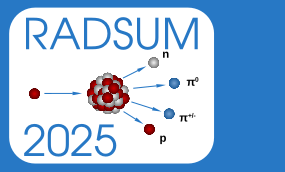Conveners
Irradiation experiments for superconductors
- Davide Gambino (Linköping University)
Irradiation experiments for superconductors
- Davide Gambino (Linköping University)
Irradiation studies on high-temperature superconductors (HTS), particularly REBCO (Rare-Earth Barium Copper Oxide), are critical for understanding their performance in high-radiation environments, such as those found in particle accelerators and fusion reactors. This work focuses on neutron irradiation experiments conducted in Japan, which investigate the effects of neutron fluences of up to...
On 2024, J-PARC achieved the goal of high-power beam operation of 1 MW for the spallation neutron source. The allowable beam power can be said to be determined by the beam intercept materials for the high-power accelerator. J-PARC plans to build a Proton Beam Irradiation facility using 400 MeV protons to study materials, especially beam intercept ones used for the high-intensity proton beam....
The results of two decades of neutron irradiation experiments on high temperature superconducting tapes (coated conductors) will be summarized. The change of the critical current is determined by a competition of improved pinning by the introduction of nanometre sized defects and a reduction of superfluid density by pair-breaking scattering on point-like defects. The latter is directly...
Understanding the effect of irradiation with fast neutrons at cryogenic operating temperature on the properties of REBCO HTS is crucial for the design of magnets for fusion tokamaks. However, suitable high flux neutron sources such as fission reactors are not widely available, performing in situ cryogenic measurements in these reactors is challenging, and neutron irradiation activates the...
The deuterium-tritium reaction is the most promising source of fusion energy for power plants but generates high-energy neutrons that compromise reactor components - from the plasma-facing walls to fusion magnets. In compact, high-field REBCO-based fusion devices, radiation damage will limit the lifespan. Simulating the fusion environment in test facilities is challenging but essential to...
HTS magnets employed in fusion plants and high-energy physics experiments will be subjected to significant gamma ray fluxes. Gamma rays ($E_γ$ > 100 keV) have energies orders of magnitude more than the binding energies of REBCO lattice ions ($E_b$ ~ 10s eV) and Cooper-pairs ($E_b$ ~ 10s meV) and are, in principle, therefore capable of altering REBCO microstructure and suppressing...
The degradation in critical temperature of REBCO coated conductors has been attributed to the generation of point defects, particularly on the oxygen sublattice. This introduces substantial challenges for observing the defects directly because the low mass oxygen atoms are not visible in the most widely used atomic resolution electron microscopy technique, high angle annular dark field...
In order to operate reliable beam-intercepting devices in the framework of energy and intensity increase for next generation accelerators, the RaDIATE collaboration (Radiation Damage In Accelerator Target Environment) managed by Fermilab, brings together existing expertise in nuclear material and accelerator targets from 20 international institutions to execute a coordinated strategy for high...
